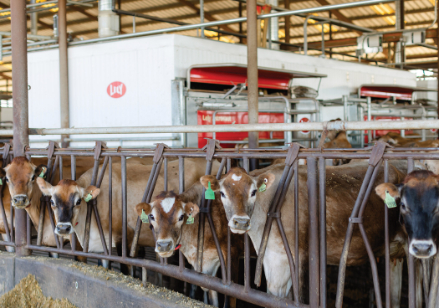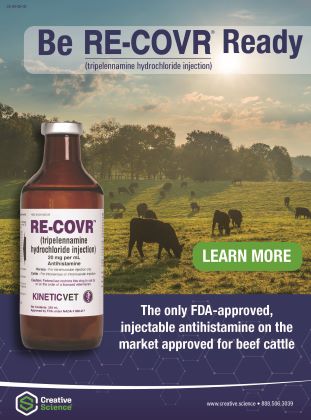Robotic Systems Continue to Revolutionize Dairy Farming

By Jaclyn Krymowski.
The continual growth of technology has not left agriculture behind. Many remember when precision crop technology was the new kid on the block not all that long ago.
Today, the tech available to farmers extends far beyond the tractor cab and a computer screen. In fact, you could say it has the potential to merge itself with nearly every single farm department including feeding, breeding, whole barn monitoring, milking units and much more.
With the rise of aggregated data, machine learning and artificial intelligence, each piece of equipment has the ability to perfect itself with each generation. Specifically in dairy, fully or partially robotic systems are becoming more commonplace.
In the USA, robotic milking systems along with cow and calf feeding systems are becoming more common, especially in the Upper Midwest and Northeast regions. These units are often installed for various reasons, but a big reason is tied to the evolving and challenging labor landscape, as noted by Marcia Endres and Jim Salfer, extension dairy educators and the University of Minnesota in their 2020 bulletin Milking dairy cows with robots.
Robotic Equipment
One of the foremost robotics seen on dairies today are milking systems, and for good reason – a few decades of data have proven that they assist in production and labor efficiency.
The primary driver for the change in milk production in comparison to a 2x day milking system did not quite reach the production of a 3x day system, write Endres and Salfer. Some of the primary factors that affect individual cow and herd average milking frequency are the number of cows, milking permission settings, feed in the box, cow fetching policy and the barn layout.
To maximize profit, it is important to maximize milk production daily. The most important factors to achieve this include the milking permissions, reduced time in the robot for the cow and having a well-maintained robot.
Automatic calf feeders are another common robotic application. However, adoption and growth in this area are notably slower compared to other technologies. A big part of this may have to do with the challenges, risks and adaptations that need to happen with calf housing, health and management.
Robotics are also quickly moving into the space of feeding, including mixing, ration balancing and even feed delivery. Not only are these made with a nod to the current farm labor crisis, but they may help farms reduce wastage by increased accuracy.
Why Robots?
Robotics are not only for large operations, they are quickly becoming popular with smaller-scale dairies that also face labor and time management challenges. Thanks to years of development coupled with machine learning, more robotic milking and feeding systems are also contributing to enhanced herd health by flagging warning signs and monitoring overall performance.
At a 2021 American Dairy Science Association meeting, survey data was shared that showed the reasons farms were moving to automated milking systems. The first was by far reducing labor costs at nearly 85%, followed by enhancing welfare (nearly 77%), herd performance (73%) and reducing current employees (69%).
Respondents seemed to agree on enhanced welfare for animals and employees, with some even commenting on enhanced reproductive performance.
The reason for greater welfare is very likely linked to the increased time budget afforded each cow. Robotic systems mean cows can select their own milking times and not need to spend hours of time walking to the parlor or waiting in the holding pen – instead, they can use that time to rest and eat more.
Calf feeding systems have similar benefits. Calves can select their own eating times and consume in larger amounts should they desire, offering greater customization to their diets.
For older animals, similar trends are noted. Lely claims that their fully automated feeding system – Lely Vector can not only increase milk per cow per day by 4 pounds but also reduce annual fuel costs by up to $10,000. This is accredited to both greater efficiency and more frequent offerings of fresh feed.
The Pitfalls
Some of the obvious downsides of robotics are the cost of maintenance and the risks of failure. In a 2017 research study in The Journal of Dairy Science, Salfer and his colleagues estimated maintenance alone to run an annual cost of approximately $9,000 per year per milking unit.
For optimum efficiency, each robot can only handle so many animals, meaning that smaller operations making a significant investment could find themselves “stuck” if they would like to consider an expansion.
Another key area is animal health – entrusting this vital area of management to robots is a hotly debated topic. No doubt, systems are getting better at flagging animals in need of treatment but still fall short of the human eye. For example, milking systems tend to rely on electric conductivity to spot mastitic cows, but research shows this is not the most effective. Likewise, partially and fully robotic parlors can only do so good of a job at teat prepping and dipping compared to the human hand.
And this is assuming all the systems are operating effectively. Power outages, mechanical breaks, computer failures and even cyber security breaches are not unheard of.
Moving forward
While there are uncertainty in the future ahead, one thing can be safely assumed – it is that robotics will, at least in some capacity, be a mainstay on tomorrow’s dairies. We may increase or decrease the levels of automation, but it will be there in some capacity so it is wise to pay attention to trends, stay educated and ensure your employees are involved with any changes.
But remember that the base of the issues is good cow management and having good people involved, day after day, directly in the care and monitoring of the herd.




